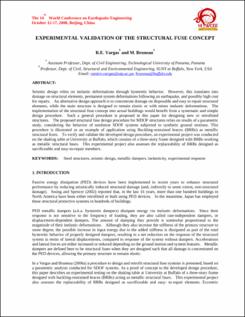Mostrar el registro sencillo del ítem
Experimental Validation of the Structural Fuse Concept
| dc.contributor.author | Vargas, Ramiro | |
| dc.contributor.author | Bruneau, Michel | |
| dc.date.accessioned | 2017-08-16T14:10:34Z | |
| dc.date.accessioned | 2017-08-16T14:10:34Z | |
| dc.date.available | 2017-08-16T14:10:34Z | |
| dc.date.available | 2017-08-16T14:10:34Z | |
| dc.date.issued | 2008-06-30 | |
| dc.date.issued | 2008-06-30 | |
| dc.identifier.uri | http://ridda2.utp.ac.pa/handle/123456789/2537 | |
| dc.identifier.uri | http://ridda2.utp.ac.pa/handle/123456789/2537 | |
| dc.description | Seismic design relies on inelastic deformations through hysteretic behavior. However, this translates into damage on structural elements, permanent system deformations following an earthquake, and possibly high cost for repairs. An alternative design approach is to concentrate damage on disposable and easy to repair structural elements, while the main structure is designed to remain elastic or with minor inelastic deformations. The implementation of the structural fuse concept into actual buildings would benefit from a systematic and simple design procedure. Such a general procedure is proposed in this paper for designing new or retrofitted structures. The proposed structural fuse design procedure for MDOF structures relies on results of a parametric study, considering the behavior of nonlinear SDOF systems subjected to synthetic ground motions. This procedure is illustrated as an example of application using Buckling-restrained braces (BRBs) as metallic structural fuses. To verify and validate the developed design procedure, an experimental project was conducted on the shaking table at University at Buffalo, which consists of a three- story frame designed with BRBs working as metallic structural fuses. This experimental project also assesses the replaceability of BRBs designed as sacrificeable and easy-to-repair members. | en_US |
| dc.description.abstract | Seismic design relies on inelastic deformations through hysteretic behavior. However, this translates into damage on structural elements, permanent system deformations following an earthquake, and possibly high cost for repairs. An alternative design approach is to concentrate damage on disposable and easy to repair structural elements, while the main structure is designed to remain elastic or with minor inelastic deformations. The implementation of the structural fuse concept into actual buildings would benefit from a systematic and simple design procedure. Such a general procedure is proposed in this paper for designing new or retrofitted structures. The proposed structural fuse design procedure for MDOF structures relies on results of a parametric study, considering the behavior of nonlinear SDOF systems subjected to synthetic ground motions. This procedure is illustrated as an example of application using Buckling-restrained braces (BRBs) as metallic structural fuses. To verify and validate the developed design procedure, an experimental project was conducted on the shaking table at University at Buffalo, which consists of a three- story frame designed with BRBs working as metallic structural fuses. This experimental project also assesses the replaceability of BRBs designed as sacrificeable and easy-to-repair members. | en_US |
| dc.language | eng | |
| dc.language.iso | eng | en_US |
| dc.rights | https://creativecommons.org/licenses/by-nc-sa/4.0/ | |
| dc.rights | info:eu-repo/semantics/openAccess | |
| dc.subject | Experimental Validation of the Structural Fuse Concept | en_US |
| dc.subject | Experimental Validation of the Structural Fuse Concept | |
| dc.title | Experimental Validation of the Structural Fuse Concept | en_US |
| dc.type | info:eu-repo/semantics/article | |
| dc.type | info:eu-repo/semantics/publishedVersion |
